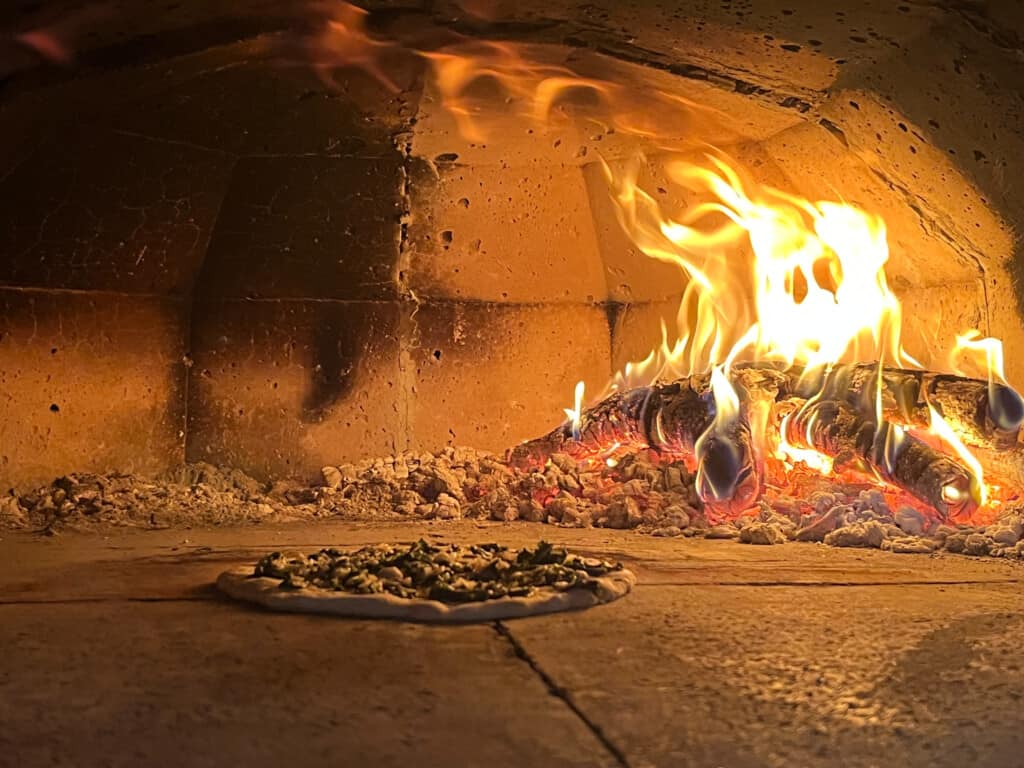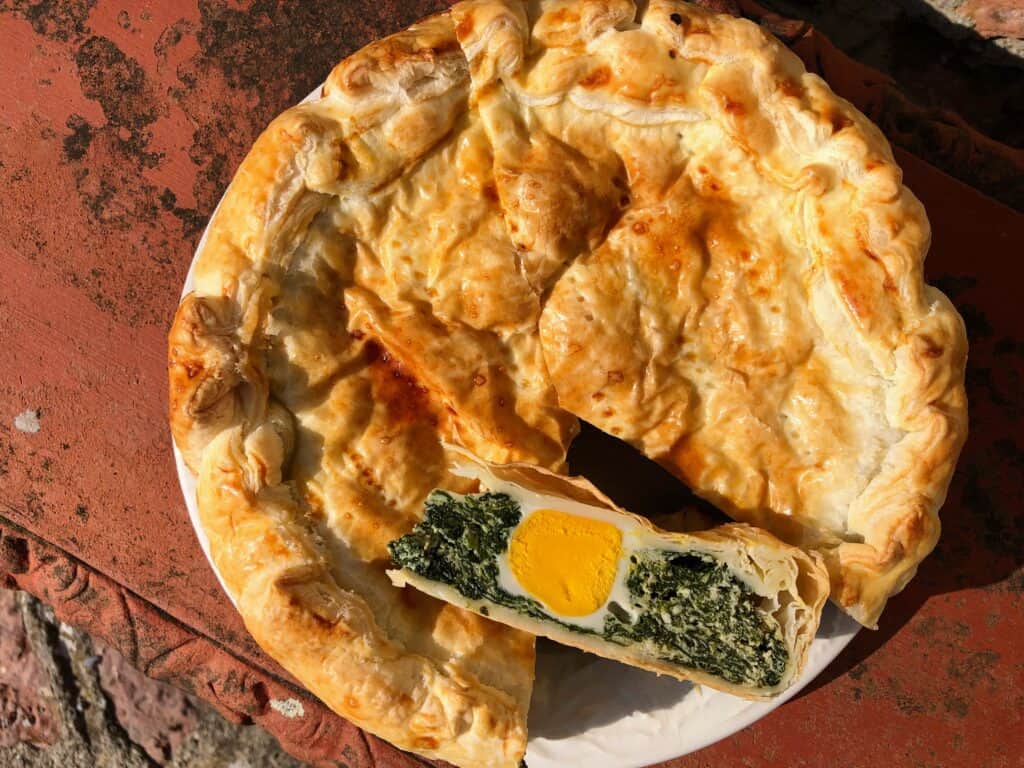Last updated on April 19th, 2024
Is there anything better than a heaping pile of handmade pasta with a stick-to-your-ribs sauce? In Tuscany where I live, pici (thick spaghetti) is the local handmade specialty.
Pici pasta is one of the easier homemade pastas to recreate at home because the recipe is very simple and it can be done by hand without any special equipment. I first learned to make pici when I moved to our home which is just 10 minutes away from Celle su Rigo, where pici pasta was ‘born.’ Ten years later, I’m still rolling out this thick spaghetti – now with my kids!
Pici pasta makes for one of the best Italian dinners that you can prepare for friends and family and it’s a great way to get the whole family involved in the kitchen. Fun and easy, this homemade spaghetti can be rolled out in no time with the help of a couple pairs of hands.
So grab your kids, a couple of friends and come together to make pici pasta and enjoy the food you prepared together, just as we do in Italy!
Jump to Section
Pici Pasta Pronunciation

Pici is pronounced pee-chee in Italian.
Listen to the pronunciation of pici here:
What Is Pici Pasta?

Pici, sometimes called pici Senesi, is a type of hand rolled thick spaghetti from Southern Tuscany that is typically served in a garlicky tomato sauce called aglione or a meat sauce called ragù in Tuscany.
The dough is made from white flour, and about half the amount of water and either olive oil or the addition of an egg.
Fact: Pici pasta is a vegan fresh pasta but if you are a traveling vegan, be sure to confirm this as some varieties are sometimes made with an egg.

This pici pasta recipe comes from one of the nonne (grandmothers) from just down the road from us who has come up to help with my kids for quite some time now. After years of demanding a specific recipe, we have finally come down to one (old-school Italians never measure anything so to get a written recipe from her took several trials together in my kitchen!).
Origins of Pici Pasta

Pici pasta was originally made from the poorest of ingredients: water and flour but now the dough is often enriched with an egg. Today, you will still find versions made with just water, flour and drizzle of oil but others prefer to make the pici pasta a bit richer with an egg, just as I do.
Before pasta was commercialized and mass-produced, it was all made at home and this pici pasta is Tuscany’s version of handmade spaghetti.
Thought to have originated in Siena by most, pici pasta is actually from Celle Su Rigo, a small hilltop town located in Southern Tuscany. Referred to as simple Celle by the locals, this town is still home to the annual sagra dei pici, the pici pasta food festival and is where you will find the absolute best homemade pici at Trattoria La Pace. This is actually the first restaurant my now-husband took me to when we first started dating way back when!
At Trattoria La Pace, you will not only find hand rolled pici by the nonne or grandmothers of Celle but you will also find some of the most humble and authentic Italian dishes in Tuscany such as beef stew, roasted wild guinea fowl and stewed rabbit.

The tradition of making hand rolled pici pasta at home is still very common throughout Tuscany. It’s a culinary tradition linked to family and community that still plays a vital role in rural towns and villages. My kids have grown up making pici with Franca, the woman just down the road, and Ada, an 88 year old woman who still makes pici for her husband on Sunday for lunch.
Tuscan Experience: For a true culinary experience, try and take a cooking class in Tuscany (insert bucket list foodie) making pici because it’s an experience you can bring home with you and share with your friends.
Store Bought Pici Pasta Vs Homemade Pici Pasta

The idea behind pici pasta is that it is hand rolled. If the strands of pici are made using a machine, then the pasta, by definition, cannot be pici.
Store bought varieties (both fresh and dried) are generally made with a machine and cannot be considered authentic pici. What sets pici apart is how they are made, by hand, creating a most rustic texture which allows the sauce to stick to the pasta well.
If you are traveling in Tuscany, I do not recommend purchasing store-bought pici unless you can clearly tell they are fresh, rolled by hand. Look for uneven long strands that are not uniform.
Pici Pasta Recipe Ingredients
Flour

For the dough, use pastry (00) or all-purpose flour (0). It isn’t going to make that much of a difference and at the end of it all, I stick to the general Italian way of cooking: use what you have and don’t throw anything away. If you have pastry flour, use that but if all you find is all-purpose, that is perfect too. You can even mix them!
To keep the pici pasta from sticking together after they have been rolled out, use a bit of semolina flour.
Water
Use warm water. This means lukewarm from the tap – not hot and not cold!
Egg
Use one egg at room temperature.
Semolina Flour
Semolina flour is important for pici pasta because it helps the pici from sticking to each other once they have been rolled out.
How To Make Pici Pasta

Measure the flour into a dome on a large work surface such as a wooden or marble board.

To make pici pasta by hand, create a well or hole in the center of the flour and crack the egg into it. Beat the egg, being sure not to disturb the well and break the walls of your flour well.
Slowly add the water to the egg, whisking and slowly incorporating the edges of the floured well walls. Once it starts to come together and enough flour has been incorporated, you can start using your hands to knead the dough. If you find the dough is a bit too dry, add a bit more water but just a teaspoon at a time.
Knead the dough by hand for 10 minutes or so until smooth and elastic.
To make pici pasta with a stand mixer, use the dough hook and add the flour to the bowl. With the mixer on low, add the egg and combine. Slowly add the warm water and continue mixing until smooth and elastic, about 4 minutes.

Shape into a ball, wrap in plastic wrap or cover with either a kitchen towel and let the pici dough rest for at least 30 minutes to develop the gluten but preferably an hour. This step is important for rolling out the pici pasta easily. You can also refrigerate the dough for up to one day.

Unwrap the dough and cut it in half. Rewrap the half you aren’t using and set aside. Roll the dough out about ¼ inch thick. Just a couple at a time, cut strips roughly ½ inch wide. Cover the rolled out dough with a dish towel while you roll the pici to keep it from drying out.
One by one, take a strip of pici dough and twist it slightly before placing onto a clear board free of flour and rolling it out into a long snake. Try and apply even, firm pressure as you press down and outwards. Start in the middle, press down and roll your hands back and forth, moving outward away from each other. Bring your hands back to the center of the pici ‘snake’ and repeat until you have achieved a thinly rolled pici. Don’t worry if it breaks, just make two pici at this point instead of one long one. Try to roll the pici thin as they will plump up significantly as they cook.

Toss each pici in semolina flour and place them on a well semolina floured tray, baking sheet or wooden board. If you are working by yourself, I suggest covering them with a kitchen towel to prevent them from drying out.

Bring a large pot of water to a rolling boil and salt well. Add the pici and stir often to prevent them from sticking to each other and the bottom of the pot. Cook until tender, anywhere from 4-8 minutes, depending on how thick or thin your pici are. Drain well and serve immediately with either aglione or ragù meat sauce.

Cooking Pasta: Cooking pasta is an art form in Italy. Read all about how to cook pasta correctly in How To Cook Pasta Like an Italian – Step-by-Step.
Pici Pasta Substitutions
To make pici pasta without an egg, simply add a bit of olive oil to keep the dough moist, about 1 tablespoon, and increase the water slightly by 40 ml. If you decide not to use an egg, as a general rule of thumb when making Italian homemade pasta dough, use about ½ the amount of water in relation to flour by weight.
How To Serve Pici Pasta

Although pici pasta is typically dressed in a garlicky tomato sauce known as aglione or meat sauce, you can really serve pici pasta with whatever sauce you like. Other common sauces are cacio e pepe, tomato sauce, mushrooms and cream and truffles.

Pici pasta is served as a first course meal in Italy, usually on its own. You should serve bread with pici pasta to mop up any sauce left over on the plate but not to actually eat with your pasta. Read A Visitor’s Guide To Eating In Italy – Italian Food Etiquette 101 (How To Order + My Tips) and Is it Illegal to Break Pasta in Italy? + Quick Guide to Italian Pasta Etiquette for more rules on eating etiquette in Italy.
More Veg Please: Check out my list of Vegetarian Dishes to Try in Italy.
Notes and Tips For Making Pici Pasta

- Please use a scale to measure flour and water. This is extremely important when making homemade pasta for the first time. Until you know what the dough should feel like, you should be weighing your ingredients to assure accuracy.
- Pici pasta is not supposed to be uniform and all the same thickness or length, so don’t be concerned about this. This is what makes pici pasta so unique!
- Pici pasta tends to plump up and is quite filling once cooked so try and roll them thinner rather than thicker.
- Once you have rolled the pici out, put them on a tray with plenty of semolina flour to prevent them from sticking. Dust more on top.
How To Make Pici Pasta Ahead

You can make pici pasta ahead of time but you do need to follow strict guidelines to prevent them from going rancid.
For same day cooking, prepare pici pasta earlier in the day and keep refrigerated until ready to cook. You can also prepare the dough and keep it tightly wrapped in plastic wrap for up to one day before rolling out. In this case, cook pici shortly after rolling out.
To make pici pasta several days beforehand, you can easily freeze the pici pasta and cook directly from the freezer, adding a couple of minutes to the cooking time.
How To Store Pici Pasta
After pici pasta has been cooked, it can be stored in an airtight container in the refrigerator for up to three days. At this point, it cannot be frozen.
Freeze uncooked pici pasta in a freezer bag for up to three months in small ‘nests’ or clumps, ensuring you have coated the pici pasta with adequate semolina flour to prevent sticking.
Do you enjoy making and eating Italian pasta? If so, check out these recipes:
Orecchiette Pasta Recipe
Pici Pasta Recipe – How To Make Tuscany’s Hand Rolled Spaghetti
Tagliatelle Recipe + How to Pronounce It
Cacio e Pepe Recipe – Pronounce it and Make it Like an Italian (+ Audio)
Fresh Pomodoro Sauce Recipe – An Italian Summer Tradition
Pomodoro Sauce Recipe – Made With Canned Tomatoes
Creamy Kale Pasta Recipe
Italian Kale Pesto Recipe
Aglione Sauce Recipe
Pappardelle alla Boscaiola Recipe

Pici Pasta
Ingredients
- 6.5 cups all-purpose flour (780 g)
- 1.5 cups warm water (345 ml)
- semolina flour
Instructions
- Measure the flour into a dome on a large work surface such as a wooden or marble board.
- To make pici pasta by hand, create a well or hole in the center of the flour and crack the egg into it. Beat the egg, being sure not to disturb the well and break the walls of your flour well.
- Slowly add the water to the egg, whisking and slowly incorporating the edges of the floured well walls. Once it starts to come together and enough flour has been incorporated, you can start using your hands to knead the dough. If you find the dough is a bit too dry, add a bit more water but just a teaspoon at a time.
- Knead the dough by hand for 10 minutes or so until smooth and elastic.
- To make pici pasta with a stand mixer, use the dough hook and add the flour to the bowl. With the mixer on low, add the egg and combine. Slowly add the warm water and continue mixing until smooth and elastic, about 4 minutes.
- Shape into a ball, wrap in plastic wrap or cover with either a kitchen towel and let the pici dough rest for at least 30 minutes to develop the gluten but preferably an hour. This step is important for rolling out the pici pasta easily. You can also refrigerate the dough for up to one day.
- Unwrap the dough and cut it in half. Rewrap the half you aren’t using and set aside. Roll the dough out about ¼ inch thick. Just a couple at a time, cut strips roughly ½ inch wide. Cover the rolled out dough with a dish towel while you roll the pici to keep it from drying out.
- One by one, take a strip of pici dough and twist it slightly before placing onto a clear board free of flour and rolling it out into a long snake. Try and apply even, firm pressure as you press down and outwards. Start in the middle, press down and roll your hands back and forth, moving outward away from each other. Bring your hands back to the center of the pici ‘snake’ and repeat until you have achieved a thinly rolled pici. Don’t worry if it breaks, just make two pici at this point instead of one long one. Try to roll the pici thin as they will plump up significantly as they cook.
- Toss each pici in semolina flour and place them on a well semolina floured tray, baking sheet or wooden board. If you are working by yourself, I suggest covering them with a kitchen towel to prevent them from drying out.
- Bring a large pot of water to a rolling boil and salt well. Add the pici and stir often to prevent them from sticking to each other and the bottom of the pot. Cook until tender, anywhere from 4-8 minutes, depending on how thick or thin your pici are. Drain well and serve immediately with either aglione or ragù meat sauce.
Notes
- Please use a scale to measure flour and water. This is extremely important when making homemade pasta for the first time. Until you know what the dough should feel like, you should be weighing your ingredients to assure accuracy.
- Pici pasta is not supposed to be uniform and all the same thickness or length, so don’t be concerned about this. This is what makes pici pasta so unique!
- Pici pasta tends to plump up and is quite filling once cooked so try and roll them thinner rather than thicker.
- Once you have rolled the pici out, put them on a tray with plenty of semolina flour to prevent them from sticking. Dust more on top.
Pici Pasta FAQ
Pici is a fresh, hand rolled pasta similar to spaghetti from Tuscany. Spaghetti is made either with a pasta machine or mass-produced and dried.
Pici refers to a thick, hand rolled pasta, similar to a thicker spaghetti.
Pici pasta dough is traditionally made of flour and half the amount of water by weight with the addition of olive oil. Today, an egg is often added to enrich the dough.
Pici is rolled exclusively by hand while bigoli from Veneto are often made from a fresh dough like pici but shaped into strands by a pasta machine.
Bucatini is a thick spaghetti, similar to pici in thickness but with a hole in the middle. Bucatini can only be made with a machine while pici are exclusively hand rolled.




